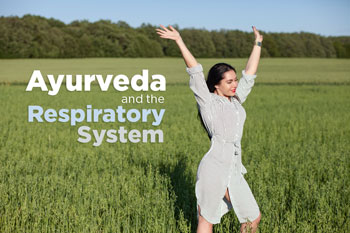Ayurveda and the Respiratory System
Author: Linda Sinden Date Posted:4 September 2019

As we breathe air flows through the nasal passages into the pharynx or throat which is shaped like a funnel. The passage of air and food move through this tunnel and it also acts as a chamber for vocal sounds produced by the vocal cords in the larynx which allows us to speak. This is often called the upper respiratory area.
About the process ...
Breathing or the process of respiration also provides oxygen to the cells and thereby stimulating metabolic reactions for the release of nutrients.
- The first portion of the pharynx or throat is the nasopharynx which transports air and mucous downwards. It also has openings into the Eustachian tubes of the ear and is involved in equalising the air pressure between the ears, nose and throat.
- The middle section, the oropharynx, receives air, food and drink from the mouth and it is here that the tonsils are found.
- The lowest portion of the pharynx, the laryngopharynx, also acts as a passageway for food, fluids and air and is connected to the larynx which produces vocal sounds when air is expelled over the vocal cords, two membranes which vibrate to produce sound.
Signs of imbalance are
When Kapha becomes imbalance in the upper respiratory area congestion in the ears, nose and throat occurs. When Vata becomes imbalanced in the upper respiratory area dryness and lack of secretion arises with a common sign being a dry tickle in the back of the throat and dryness in the nasal passages. If Pitta becomes imbalanced in this area it lease to inflammation, ulcers and redness with conditions finishing in ‘itis’ like sinusitis and rhinitis.
Let’s look a little deeper
Although symptoms of respiratory disease often indicate Kapha out of balance, such as excess mucous and congestion, this is usually a reaction to the excess dryness of Vata or the inflammation of a Pitta imbalance.
- Increased Vata in the environment; such as cold, windy weather or in our lifestyle such as smoking, excessive travel, stress and lack of rest; dries out the tissues in our body.
- Our mucous membranes in our nose and the lubrication in our lungs can begin to dry out or become deranged in some way. Therefore we become more sensitive to outside pollutants such as pollen and dust.
- Irritation and inflammation are present in asthma, bronchitis, rhinitis, emphysema and pneumonia. Pollution, cigarette smoke, pollen, dust and some chemicals cause the airways to become inflamed.
- The physiology reacts by increasing Kapha, in the form of mucous or fluid, to soothe the aggravated Pitta.
Reduce Toxins and Improve Digestion
Reducing ama or toxins from the physiology is an important step in rectifying respiratory problems. Ama can come from improper diet and environmental toxins or a weakness in the digestive system. Even if the intake of food is wholesome, if the physiology is unable to digest it properly it can cause accumulation of ama. Having regular exercise, drinking warm boiled water and reducing heavy food such as meat, cheese and desserts will help to both strengthen the metabolism and reduce ama in the respiratory system.
Balance Kapha
- Eating lighter in the evening, with the largest quantity of food at lunchtime, and avoiding left overs, processed food, cold food and drinks helps to prevent the accumulation of ama.
- It is best to favour a Kapha balancing diet of wholegrains including barley, vegetables including leafy greens, broccoli and cauliflower, fruit such as stewed apples and pears and spices such as cumin, coriander, turmeric, ginger, cloves, black pepper and fennel seeds.
- Avoid cheese, yogurt, chocolate, and potatoes especially if there is congestion.
- Take 2-4 tablets of Digest Tone at bedtime.
- It is best to get out of bed before 6am to offset the heaviness of Kapha and to wake up all the channels in the body.
- A daily walk of 15-20 minutes is also very helpful.
Balance Vata and Pitta
Balance Vata by staying warm and keeping your head, neck and chest covered. A daily oil massage with warm sesame oil is great for immunity and pacifying Vata but should be discontinued if there is already a respiratory imbalance as the massage can push the ama deeper into the physiology. If there is Pitta aggravation or irritation it is best to reduce oranges, pineapple, tomatoes and stimulants especially nicotine and alcohol.
Herbal Preparations
A Maharishi Ayurveda inhalation preparation called Breathe Easy Oil containing essential oils of camphor, eucalyptus, clove and fennel is very useful for clearing congestion from the airways. It can also be used to help give comfort to the forehead, joints and muscles.
Protection Plus Sinuses
To help protect your sinuses from the onslaught of spring and summer pollens it is useful to start taking Protection Plus Sinuses now. Myrobalans, Bhasmas and Marshmallow Root work to support lubrication of the sinuses while Boerhavia and Lebbeck Tree help to cleanse in order to maintain the health of the sinuses. As we have some bottles nearing their expiry date at the end of this month, we are offering a 50% reduction on Protection Plus Sinuses until this stock runs out. This is a bargain!
50% off Protection Plus Sinuses now
Wishing you the bliss of a robust upper respiratory area this spring and summer!
|
Linda Sinden has been a practising Maharishi Ayurveda Consultant since 1990 and is a regular contributor to our weekly Insights. She has a practice in Auckland, New Zealand and also provides phone or Skype sessions for those who need assistance, but don’t have a consultant in their vicinity. Email: lindasinden@orbislife.co.nz Skype: Linda.Sinden |
.jpg) |


